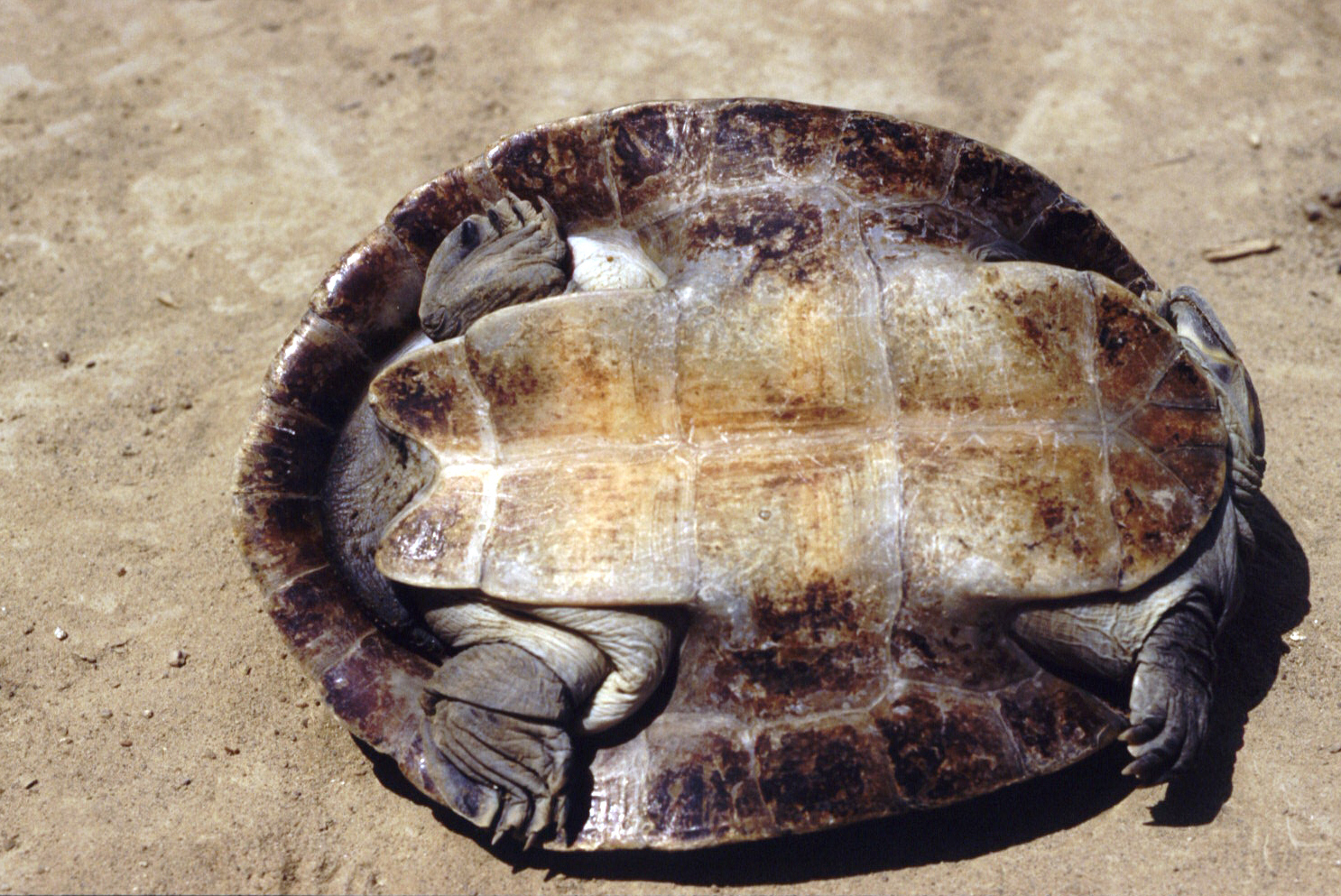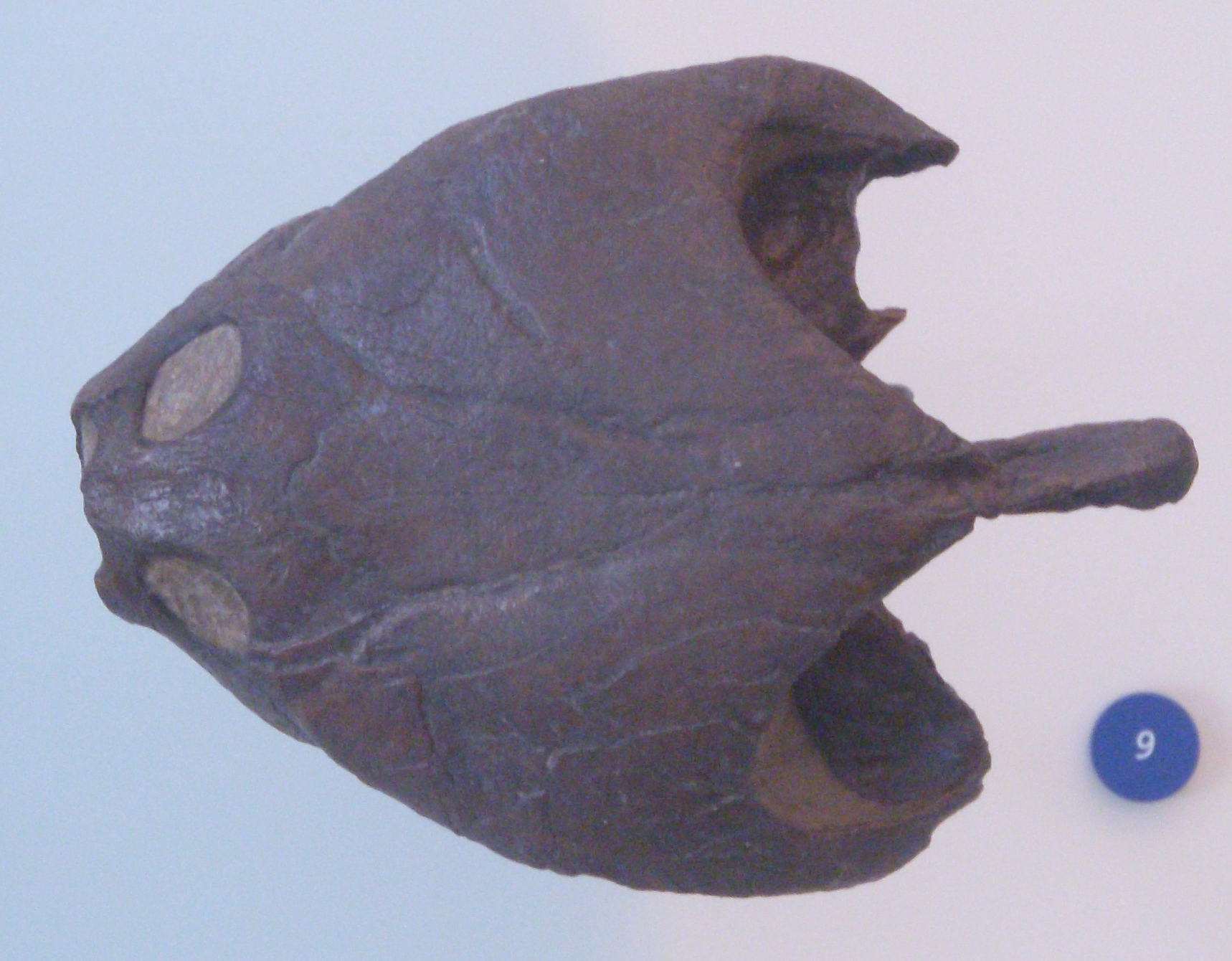|
Podocnemididae
Podocnemididae is a family of pleurodire (side-necked) turtles, once widely distributed. Most of its 20 genera and 30 species are now extinct. Seven of its eight surviving species are native to South America: the genus ''Peltocephalus'', with only one species (''P. dumerilianus'', the big-headed Amazon River turtle); and the genus ''Podocnemis'', with six living species of South American side-necked river turtles. There is also one genus native to Madagascar: ''Erymnochelys'', the Madagascan big-headed turtle, whose single species ''E. madagascariensis''. Like other pleurodire turtles, podocs have a "side-necked" defensive posture, turning the head sideways to hide it under the shell. Another characteristic of pleurodires is that the pelvis is fused to the shell which prevents pelvic motion, making it difficult to walk on land. Podocnemididae turtles live in aquatic environments and have shells streamlined to aid in swimming. Taxonomy and systematics According to Ferreira et ... [...More Info...] [...Related Items...] OR: [Wikipedia] [Google] [Baidu] |
Stupendemys
''Stupendemys'' is an extinct genus of freshwater side-necked turtle, belonging to the family Podocnemididae. It is the largest freshwater turtle known to have existed, with a carapace over 2 meters long. Its fossils have been found in northern South America, in rocks dating from the Middle Miocene to the very start of the Pliocene, about 13 to 5 million years ago. Male specimens are known to have possessed bony horns growing from the front edges of the shell and the discovery of the fossil of a young adult shows that the carapace of these turtles flattens with age. A fossil skull described in 2021 indicates that ''Stupendemys'' was a generalist feeder. History and naming ''Stupendemys'' was first named in 1976 by Roger C. Wood based on specimen MCNC-244, the medial portion of a large sized carapace with associated left femur, scapulacoracoid and a cervical vertebra. Wood also described several other specimens he referred to ''Stupendemys'', which includes MCZ(P)-4376. This ... [...More Info...] [...Related Items...] OR: [Wikipedia] [Google] [Baidu] |
Pleurodira
The Pleurodira are one of the two living suborders of turtles, the other being the Cryptodira. The division between these two suborders represents a very deep evolutionary divide between two very different types of turtles. The physical differences between them, although anatomical and largely internal, are nonetheless significant, and the zoogeographic implications of them are substantial. The Pleurodira are known more commonly as the side-necked turtles and the name Pleurodira quite literally translates to side neck, whereas the Cryptodira are known as hidden-necked turtles. The Pleurodira turtles are currently restricted to freshwater habitats in the Southern Hemisphere, largely to Australia, South America, and Africa. Within the Pleurodira, three living families are represented: Chelidae, also known as the Austro-South American side-necked turtles, the Pelomedusidae, also known as the African mud terrapins, and the Podocnemididae, also known as the American side-neck river tur ... [...More Info...] [...Related Items...] OR: [Wikipedia] [Google] [Baidu] |
Pelomedusidae
:''Alternatively, "Pelomedusidae" may refer to the Pelomedusoidea. See below for details.'' Pelomedusidae is a family of freshwater turtles endemic to sub-Saharan Africa, including Madagascar, São Tomé, and the Seychelles(Although this pop. may have been introduced by humans). They range in size from in carapace length, and are generally roundish in shape. They are unable to fully withdraw their heads into their shells, instead drawing them to the side and folding them beneath the upper edge of their shells, hence are called African side-necked turtles. The family contains two living genera. They are distinguished from their closest relatives by a hinge in the front section of the plastron.Obst, Fritz Jürgen (1998): elomedusinae ''In:'' Cogger, H.G., & Zweifel, R.G. (eds.): ''Encyclopedia of Reptiles and Amphibians'': 112-113. San Diego: Academic Press. . Pelomedusidae spends most of its time in the mud at the bottom of rivers or shallow lakes, where they eat invertebrate ... [...More Info...] [...Related Items...] OR: [Wikipedia] [Google] [Baidu] |
Turtle
Turtles are an order of reptiles known as Testudines, characterized by a special shell developed mainly from their ribs. Modern turtles are divided into two major groups, the Pleurodira (side necked turtles) and Cryptodira (hidden necked turtles), which differ in the way the head retracts. There are 360 living and recently extinct species of turtles, including land-dwelling tortoises and freshwater terrapins. They are found on most continents, some islands and, in the case of sea turtles, much of the ocean. Like other amniotes (reptiles, birds, and mammals) they breathe air and do not lay eggs underwater, although many species live in or around water. Turtle shells are made mostly of bone; the upper part is the domed carapace, while the underside is the flatter plastron or belly-plate. Its outer surface is covered in scales made of keratin, the material of hair, horns, and claws. The carapace bones develop from ribs that grow sideways and develop into broad flat plates th ... [...More Info...] [...Related Items...] OR: [Wikipedia] [Google] [Baidu] |
Podocnemis Skulls, Ventral And Side View, From The Osteology Of The Reptiles, Page 43
''Podocnemis'' is a genus of aquatic turtles, commonly known as South American river turtles, in the Family (biology), family Podocnemididae. The genus consists of six Extant taxon, extant species occurring in tropical South America.''Podocnemis'' The Reptile Database. www.reptile-database.org. Three additional species are known only from fossils. Species These six species are extant. *''Podocnemis erythrocephala'' – red-headed Amazon River turtle *''Podocnemis expansa'' – Arrau turtle *''Podocnemis lewyana'' – Magdalena River turtle *''Podocnemis sextuberculata'' – six-tubercled Amazon River turtle *''Podocnemis unifilis'' – yellow-spotted river turtle, yellow-headed sideneck *''Podocnemis vogli'' – savanna side-necked turtle ...[...More Info...] [...Related Items...] OR: [Wikipedia] [Google] [Baidu] |
Bothremydidae
Bothremydidae is an extinct family of side-necked turtles (Pleurodira) known from the Cretaceous and Cenozoic. They are closely related to Podocnemididae, and are amongst the most widely distributed pleurodire groups, with their fossils having been found in Africa, India, the Middle East, Europe, North America and South America. Bothremydids were aquatic turtles with a high morphological diversity, indicative of generalist, molluscivorous, and piscivorous diets. Unlike modern pleurodires, which are exclusively freshwater, bothremydids inhabited freshwater, marine and coastal settings. Their marine habits allowed bothremydids to disperse across oceanic barriers into Europe and North America during the early Late Cretaceous (Cenomanian). The youngest records of the group are indeterminate remains from Saudi Arabia and Oman, dating to the Miocene. Taxonomy The family is split into two subfamilies and a number of tribes. Bothremydidae *'' Pleurochayah appalachius'' Adrian et al., ... [...More Info...] [...Related Items...] OR: [Wikipedia] [Google] [Baidu] |
Peltocephalus
The big-headed Amazon River turtle (''Peltocephalus dumerilianus''),"''Peltocephalus dumerilianus'' " The Reptile Database. also known as the big-headed sideneck, is a of in the . The species is |
Podocnemis
''Podocnemis'' is a genus of aquatic turtles, commonly known as South American river turtles, in the family Podocnemididae. The genus consists of six extant species occurring in tropical South America.''Podocnemis'' The Reptile Database. www.reptile-database.org. Three additional species are known only from fossils. Species These six species are extant. *''Podocnemis erythrocephala'' – *''Podocnemis expansa'' – *''Podocnem ...[...More Info...] [...Related Items...] OR: [Wikipedia] [Google] [Baidu] |
Big-headed Amazon River Turtle
The big-headed Amazon River turtle (''Peltocephalus dumerilianus''),"''Peltocephalus dumerilianus'' " The Reptile Database. also known as the big-headed sideneck, is a species of turtle in the Family (biology), family Podocnemididae. The species is monotypic within the genus ''Peltocephalus''. Etymology The Specific name (zoology), specific name, ''dumerilianus'', is in honor of French people, French Herpetology, herpetologist André Marie Constant Duméril.species:Bo Beolens, Beolens, Bo; species:Michael Watkins, Watkins, Michael; Grayson, Michael (2011). ''The Eponym Dictionary of Reptiles''. Baltimore: Johns Hopkins University Press. xiii + 296 pp. . (''Peltocephalus dumeriliana'', ...[...More Info...] [...Related Items...] OR: [Wikipedia] [Google] [Baidu] |
Quadrate Bone
The quadrate bone is a skull bone in most tetrapods, including amphibians, sauropsids (reptiles, birds), and early synapsids. In most tetrapods, the quadrate bone connects to the quadratojugal and squamosal bones in the skull, and forms upper part of the jaw joint. The lower jaw articulates at the articular bone, located at the rear end of the lower jaw. The quadrate bone forms the lower jaw articulation in all classes except mammals. Evolutionarily, it is derived from the hindmost part of the primitive cartilaginous upper jaw. Function in reptiles In certain extinct reptiles, the variation and stability of the morphology of the quadrate bone has helped paleontologists in the species-level taxonomy and identification of mosasaur squamates and spinosaurine dinosaurs. In some lizards and dinosaurs, the quadrate is articulated at both ends and movable. In snakes, the quadrate bone has become elongated and very mobile, and contributes greatly to their ability to swallow very ... [...More Info...] [...Related Items...] OR: [Wikipedia] [Google] [Baidu] |
Genera
Genus ( plural genera ) is a taxonomic rank used in the biological classification of living and fossil organisms as well as viruses. In the hierarchy of biological classification, genus comes above species and below family. In binomial nomenclature, the genus name forms the first part of the binomial species name for each species within the genus. :E.g. ''Panthera leo'' (lion) and ''Panthera onca'' (jaguar) are two species within the genus '' Panthera''. ''Panthera'' is a genus within the family Felidae. The composition of a genus is determined by taxonomists. The standards for genus classification are not strictly codified, so different authorities often produce different classifications for genera. There are some general practices used, however, including the idea that a newly defined genus should fulfill these three criteria to be descriptively useful: # monophyly – all descendants of an ancestral taxon are grouped together (i.e. phylogenetic analysis should clearly demons ... [...More Info...] [...Related Items...] OR: [Wikipedia] [Google] [Baidu] |
Late Cretaceous
The Late Cretaceous (100.5–66 Ma) is the younger of two epochs into which the Cretaceous Period is divided in the geologic time scale. Rock strata from this epoch form the Upper Cretaceous Series. The Cretaceous is named after ''creta'', the Latin word for the white limestone known as chalk. The chalk of northern France and the white cliffs of south-eastern England date from the Cretaceous Period. Climate During the Late Cretaceous, the climate was warmer than present, although throughout the period a cooling trend is evident. The tropics became restricted to equatorial regions and northern latitudes experienced markedly more seasonal climatic conditions. Geography Due to plate tectonics, the Americas were gradually moving westward, causing the Atlantic Ocean to expand. The Western Interior Seaway divided North America into eastern and western halves; Appalachia and Laramidia. India maintained a northward course towards Asia. In the Southern Hemisphere, Australia and Ant ... [...More Info...] [...Related Items...] OR: [Wikipedia] [Google] [Baidu] |






